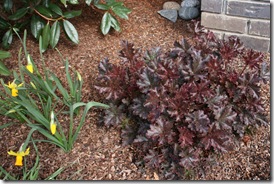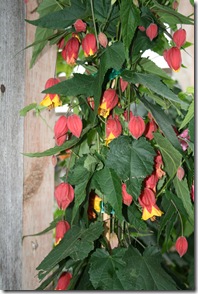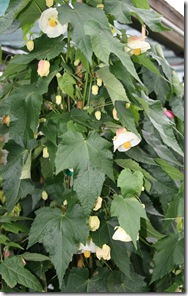Finishing off our series on planting to attract birds, here’s my love poem to container gardeners – some of my favorite plants to attract birds and hummingbirds to your urban or patio garden.
Fuchsia thymifolia or Fairy Fuchsia
This is the fuchsia that makes me go starry-eyed with love. Blooming all year long on the coast, this delicate thyme-leaved beauty is a huge favorite with the hummingbirds. If you’re used to the hybrids with honkin’ big flowers, re-adjust your view to this all-natural beauty. The simple, tiny flowers are just gorgeous, and the benefit of less breeding is that they are sturdy and strong. No Fuchsia gall mite here.
 People in colder climes may need to protect it in winter, as it’s only hardy to 20 degrees, but if you are a fan of Fuchsias, your garden won’t be complete without this one. I’ve had them get to 3’ in containers, and their arching, upright habit makes them a perfect centerpiece.
People in colder climes may need to protect it in winter, as it’s only hardy to 20 degrees, but if you are a fan of Fuchsias, your garden won’t be complete without this one. I’ve had them get to 3’ in containers, and their arching, upright habit makes them a perfect centerpiece.
 There’s also a white-variegated version called ‘Lottie Hobbie’, which has a smaller, more creeping habit to about 2’. Since the variegated foliage sunburns easily, I set them in part to full shade and let them fill in around a more upright plant.
There’s also a white-variegated version called ‘Lottie Hobbie’, which has a smaller, more creeping habit to about 2’. Since the variegated foliage sunburns easily, I set them in part to full shade and let them fill in around a more upright plant.
Heuchera or Coral Bells
Who doesn’t love the airy spikes of reddish bellflowers found on the traditional green Coral Bells, or the wild foliage on some of the varieties? While hummingbirds seem to more readily notice the red or pink-flowered varieties, they will also drink from the white bellflowers found on many Heucheras if they happen to be in the area.
 I love tucking Heucheras around a taller centerpiece plant to fill in and add cheery foliage interest even in the seasons they aren’t blooming. Most do best in part shade, but if you have a sunny container, try a red or green variety with crinkly leaves like ‘Crimson Curls’ (pictured) or my new love ‘Sashay’. I’ve found them less prone to sunburn.
I love tucking Heucheras around a taller centerpiece plant to fill in and add cheery foliage interest even in the seasons they aren’t blooming. Most do best in part shade, but if you have a sunny container, try a red or green variety with crinkly leaves like ‘Crimson Curls’ (pictured) or my new love ‘Sashay’. I’ve found them less prone to sunburn.
Some favorites?
Try ‘Vesuvius’, with rich purple foliage and bright pink flowers. It really warms up a shady corner, and the flowers are so attractive to hummingbirds.
‘Marmalade’ is one of the few amber varieties that really seems to do well in coastal Northern Cali – the other amber-colored ones just limp along, but ‘Marmalade’ is a powerhouse – both in foliage and flower.
‘Paris’ is a feminine-looking silvery-green thing with gentle pink flowers. It looks great with white or cream variegation nearby. The hummingbirds flock to those pink blooms!
Small Ornamental Grasses
We’ve talked about how grasses provide seeds to eat in the winter, so long as you don’t cut them back too early (I wait until mid-January for Miscanthus, and mid-March for Pennisetums that go dormant). Grasses bring a sense of airiness and motion to the garden, and look great by themselves or planted with annuals.
Pennisetum ‘Little Bunny’ has the cutest little beige poofs for flowers, and they’re only 18” tall when in full bloom! I love the way they sway in the wind.
Miscanthus ‘Little Kitten’ has shimmery white blooms that catch the light nicely. The foliage only gets to 18”, then the flowers rise on bare stems another 18” above that. It has a graceful and flowing look.
Miscanthus ‘Little Zebra’ has bright green foliage with vivid gold bands running across the leaves. Those gold highlights look great against a cobalt blue pot.
Despite the name, ‘Little Zebra’ isn’t actually little except in comparison to its parent. The foliage reaches 3’ and the copper-colored flower plumes are held a foot above the foliage. I let them take an entire pot to themselves and call them a focal point.
Clianthus puniceus or Parrot’s Beak
Who knew such a tropical plant could be so hardy? My favorite Oregonian nurserymen over at Xera Plants tell me it regularly survives winters as cold as 15 degrees in the ground, though in a container it should be protected from frost as much as possible.
 I can’t believe my eyes every spring when mine produces crazy, 2” long lobster-claw flowers that hang from the arching branches. The hummingbirds love the nectar and zoom back and forth to it through the day.
I can’t believe my eyes every spring when mine produces crazy, 2” long lobster-claw flowers that hang from the arching branches. The hummingbirds love the nectar and zoom back and forth to it through the day.
There are pink, red, and salmon-colored versions, as well as a white one called ‘Alba’. They’ll get to 8-10’ in the ground, but stay happy for years in a container with occasional repotting.
Acer palmatum or Japanese Maple
Japanese Maples are a staple of container gardens, with good reason. They’re easy to keep, and there’s a style of foliage and habit that will work for any garden. In winter, birds love to eat the seeds inside their winged fruits (or samaras).
Around here, the Coral Bark (’Sango Kaku’), ‘Crimson Queen’, and ‘Bloodgood’ Maples get a lot of play, and deservedly so – they are gorgeous! Of those, ‘Crimson Queen’ does best in a container, since it is slow-growing and looks great elevated in a pot where you can allow the foliage to cascade. The others are more vigorous and will eventually want to be in the ground.
My picks for pots?
‘Beni Maiko’ is a favorite that deserves to be much better known. The spring foliage comes out a glowing pinky-red and turns gradually to green, then in late summer puts out a second flush of bright red growth which highlights nicely against the green foliage. Great fall color, too, and with an ultimate size of 6’ in a pot, you won’t need to worry about finding it a “forever home”. Check out the photos here.
‘Beni Shichihenge’ is another fun one, with minty-green foliage edged with eye-popping pink and white. Wow! Let it take center stage in your planting area by surrounding it with pots of shiny Tassel Ferns, white Astilbes, or a dwarf Mugo Pine. Give this one a bit of shade; the variegation makes it more prone to burn.
Abutilon megapotamicum and hybrids or Flowering “Maple”
My local hummingbirds guard my Abutilons jealously, warning off intruders with high-pitched tweets. No wonder, too! They bloom profusely through some tough times of the year, at least in a mild-winter climate, and those hanging bells are full of tasty nectar.
The thing to watch with all Abutilons is that they can get leggy, so when they are growing vigorously I pinch all the new shoot tips off to the first side-shoot to encourage bushiness (and more flowers!).
 In a patio garden, the leggy A. megapotamicum varieties can be espaliered or twined through a trellis to create a flowering screen. They tend to come in hotter colors like reds, oranges, and yellows, and my favorite is ‘Orange Hot Lava’, a loosely growing one to about 5’. I’ve had luck with all the A. megapotamicum varieties in containers.
In a patio garden, the leggy A. megapotamicum varieties can be espaliered or twined through a trellis to create a flowering screen. They tend to come in hotter colors like reds, oranges, and yellows, and my favorite is ‘Orange Hot Lava’, a loosely growing one to about 5’. I’ve had luck with all the A. megapotamicum varieties in containers.
The hybrid Abutilons come in all kinds of sizes and colors – white, pink, yellow, red, and everything in between. All will do well in containers for a year or two, but for a long-term planting choose one with a mature size of 4’ or less.
 To provide winter food for hummingbirds, I cut my Abutilons back by half in mid-August (even if they look great), so they have time before winter to grow a whole new crop of flowers. To me, winter interest and providing food at a tough time of year is more important than its looks in the summer, but you’re welcome to prune them any time of year that suits you – they are remarkably unfussy about such things.
To provide winter food for hummingbirds, I cut my Abutilons back by half in mid-August (even if they look great), so they have time before winter to grow a whole new crop of flowers. To me, winter interest and providing food at a tough time of year is more important than its looks in the summer, but you’re welcome to prune them any time of year that suits you – they are remarkably unfussy about such things.
Monterey Bay Nursery has the best guide to Abutilons online, so if you want to plot out which variety to to buy, head on over there and check out their descriptions and photos.
I hope you’ve found a few new favorites to plant for your container garden. Tell me in the comments – what are your favorite container plants to attract birds and hummingbirds?



9 responses to “Container Plants that Birds Love”
Wow-these are some interesting plants; thank you for sharing them. I really like the looks of the Parrot Beak!! The fuschia (mini’s) are sweet; I think that would be a perfect thing to have in the garden. I think it’d be easier for me to deal with in a container, too. I love the first photo of the bird…I’m a bird fanatic;-)
Jan (ThanksFor2Day)’s last blog post..Birds Before Beds: Winter Backyard Bird Series #2
Coral bells rule. Rule I tell you! Fuchsias here are considered annuals. I’ve only seen the “honking” big kind and wasn’t wild about them (I know, but that’s how I am!). I’ll try to find the fairy version, which are more to my liking.
Monica’s last blog post..Froggies!
Love the Parrot’s Beak – I’ve never seen that before. Great and informative information with some new plants I didn’t know about, but then there are lots of those!
RainGardener’s last blog post..Making The Computer Understand
What a great post! I love abutilon. And heuchera. And that Clianthus puniceus looks really interesting too!
Renate’s last blog post..Fantastic Fremontodendron – First Flower
[…] Genevieve wraps up her series on planting to attract birds with a great post on plants that work well in a container garden that birds love. […]
Great post Genevieve! I have been thinking about adding an Abutilon for a while, although I was going to keep it indoors. Maybe I should reconsider, attracting hummers would be worth the space on my patio.
Fern’s last blog post..Spring Brings Great Container Gardening Links…
Hi Jan! Thanks for visiting – you sure get some gorgeous birds at your home – much more variety than we have here!
Monica, I’ll tell you a secret – I don’t like the honking big ones very much either! The regular species varieties are so delicate and pretty to me. Plus, the highly bred ones get that gall mite here, but I have no problems with thymifolia.
RainGardener, isn’t that Parrot’s Beak awesome? It is a new-ish plant to me – I’ve only had mine for two springs now, but it’s been a sturdy plant. I’m thankful to Greg over at Xera Plants for introducing me to it and giving me such a thorough rundown of how it does in his) slightly colder) climate.
Thanks Renate! For my part, I’m a total fan of Fremontodendrons, too!
Fern, your climate may be different because you probably get stronger light indoors, but I have not personally had good luck with them indoors. Their foliage gets a bit too lush and then gets whiteflies, which are hard to get rid of totally after that. If you do try one inside, let me know how it works out for your clime!
Right now I’m focusing on planting edibles for my vegetable garden, but I do have four half wine barrels that I made into planters and filled with dirt. Maybe I’ll have to try some of these to attract the birds. Unfortunately, the neighbor has a couple of outdoor cats that like to hunt birds, so I’m reluctant to invite my feathered friends down to their level.
Lindsay’s last blog post..Cashing in & Staying Motivated with Short Blog Posts
[…] Genevieve wraps up her series on planting to attract birds with a great post on plants that work well in a container garden that birds love. […]